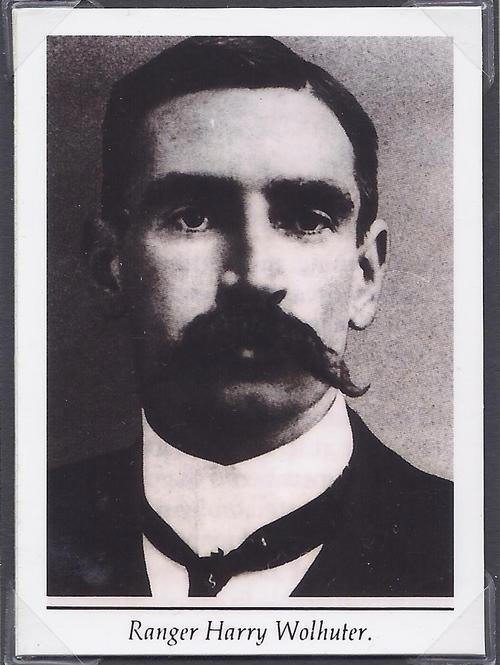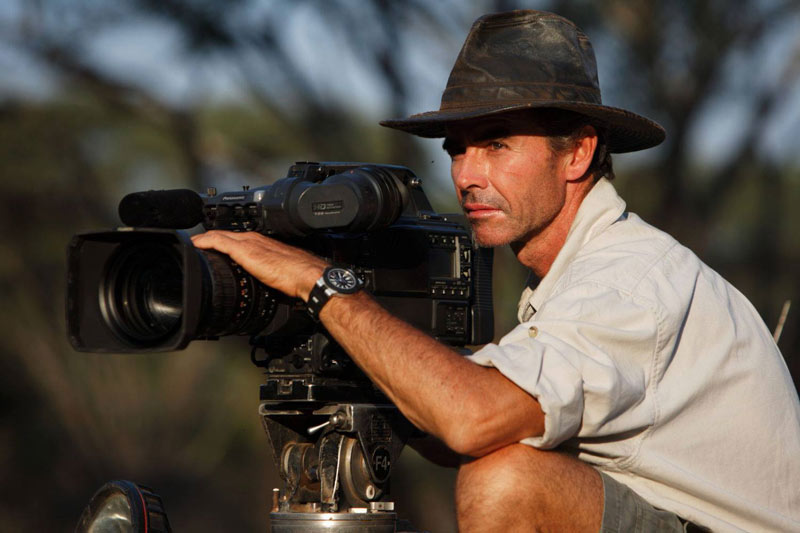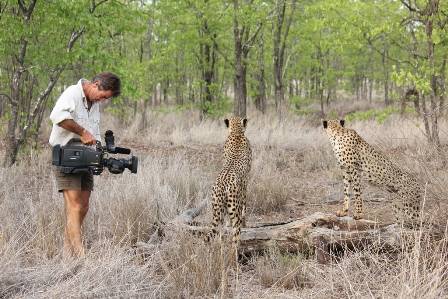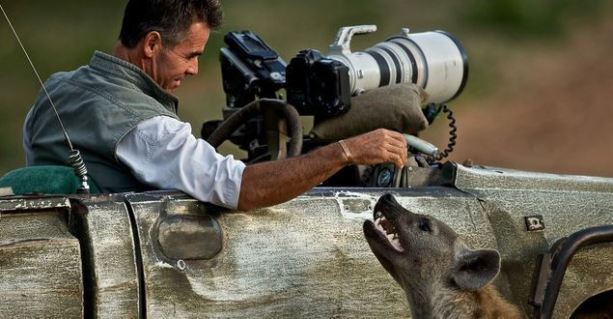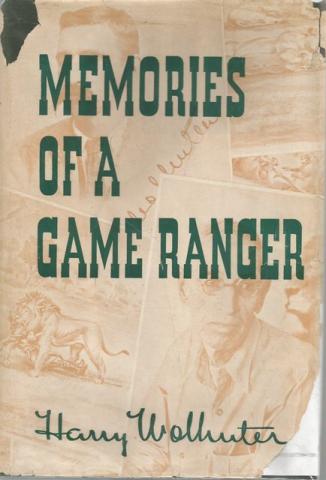Wolhuter Family
Psions of the bushveld..
Wolhuter - legends of Kruger (and beyond)
Three generations from pioneering game ranger to revolutionary filmaker.
The name Harry Wolhuter is somewhat of a legend in South African conservation circles. As the first game ranger in the Kruger National Park under James Stebeson-Hamilton, he was lucky enough to survive an attack from two fully grown male lions while on horseback in the early days of the Park. He was pulled off his horse and being dragged by the shoulder but fortunate enough to get a hold of his sheath knife and mortally stab one of the males. Harry credited his survival to his faithful dog, Bull, who’s insistent barking distracted the second lion, granting him the opportunity to climb up a nearby tree until help arrived.
Some years later, Kim Wolhuter, grandson of Harry and son of Senior Ranger Henry Wolhuter, became one of the continent's most extraordinary wildlife filmmakers. Sadly Kim’s father did not have much influence on his life, as he passed away when Kim was only 5 years old. He picked up most of his bush knowledge from Ted Reilly, while helping him out during university holidays. He finds himself hugely indebted to Ted as “besides for my mother, I must give him credit for who I am today”.
HARRY'S STORY
Harry Wolhuter served as the first game ranger in the Kruger National Park, South Africa and went on to complete 44 years of service from 1902 until 1946.
His character is summed up by the warden of the park at the time, Colonel James Stevenson-Hamilton: “I suppose there can be few if any men in all Africa possessing a deeper knowledge and wider experience of bush lore in all its phases and in his prime he held all the qualities requisite to give effect to that knowledge and experience; a powerful frame, an iron constitution; cool courage and quiet determination. In addition, his complete mastery of the local Bantu language, and acquaintance with their customs, earned him exceptional liking and respect among the tribal natives.”
"Tall, spare, but powerfully built; purposeful, for all his quiet voice and unassuming manner, he seemed emblematical of the best type of pioneer hunter." This was Lt. Colonel Stevenson - Hamilton's estimate of Wolhuter when they first met in 1902. The Colonel had just been made Warden of the newly - reproclaimed Sabi Game Reserve, and he needed game rangers to build up and patrol the Lowveld morgen in which the game had been severely reduced during the recent Anglo- Boer War. In Wolhuter, who had in previous years embarked upon big - game shooting trips in that very area, he found just the right man. Until Wolhuter's retirement 44 years later, they got on well together. " One could have no better chief," Wolhuter wrote.
Born in Beaufort West, Cape, on the 14th February 1877, Wolhuter lived a life of freedom in the veld. From the time he could first remember he was a hunter, with a catapult, an air gun, finally graduating to an old muzzle loader. He and his friends made their own gunpowder and percussion caps from match -heads. At 14 he left school and started work in a trading store in Maraisburg, Transvaal. He later became a shepherd, a big - game hunter, and, during the Anglo -Boer War a member of the colourful band of mounted soldiers known as Steinacker's Horse.
In game ranging Wolhuter found his true vocation. During his period of service he had the satisfaction of seeing his reserve, renamed The Kruger National Park, grow into, perhaps, the best - known and most popular wild life sanctuary in the world. He wrote: " My long experience has taught me that, thrilling through the pleasures of shooting undoubtedly are, infinitely greater and far more lasting pleasure and interest can be obtained from the observation and study of wild animals, unafraid and uninterfered with, in their natural haunts; and I have never regretted my metamorphosis from hunter to guardian!"
A wound incurred after being dragged off by a lion, together with severe bouts of malaria, permanently affected his health. He retired in 1946. His Memories of a Game Ranger written in a most readable and modest manner were brought out in 1948 by The Wild Life Protection Society of South Africa. It is from this book that these extracts are taken.
An extract from a biography by Professor Geoffrey Haresnape from his book "The Great Hunters"
Go back to: Families & Species Ambassadors
KIM'S STORY
Kim Wolhuter, who was born and raised in Skukuza in the Kruger National Park, in South Africa, comes by his love of the wild from both his grandfather and father, who were rangers. After graduating from school, he completed his two-year compulsory national service, which he fulfilled in the South African mounted infantry, fighting guerrilla warfare on the then-South West African/Angola border.
He was then free to enter the wildlife arena — he has a degree in Grassland Science — managing a game farm in Botswana. He later served as Senior Warden of Mlawula Nature Reserve in Swaziland, prior to fortuitously meeting filmmaker Richard Goss, who suggested they work together. A career filming wildlife was something that Wolhuter had never considered and one he took to immediately.
In 1988 I was approached by wildlife film producer, Richard Goss, about joining him as his assistant doing the lighting for him on a project on Spotted Hyaenas. At the time I had no interest in filmmaking and hardly any interest in photography. Following that project he gave me the camera and 10 rolls of film and said go for it on a new project on Brown Hyaenas. I ended up shooting most of that production and have been shooting ever since. I started my own production company, Mavela Media, in 1995. (Courtesey: Interview with SafariTalk).
After working with Goss for six years, Wolhuter, 34, went out on his own, creating Wildhooters Production Company, which documents southern African wildlife.
“Man, Cheetah, Wild” for the Discovery channel is his most recent project. Unlike other natural history cameramen, Wolhuter doesn’t film from a Jeep or a hideaway. He films on foot. For this special, he walks with cheetahs, he hunts with cheetahs, and he sleeps with cheetahs.
“I’ve spent so much time with them, they’ve gotten to know me and I’ve gotten to know them,” he says. “There’s never actually been a case where cheetah have killed a person. So of all the predators — the lions, leopards, wild dogs, hyenas — the cheetah are the most timid. They would rather run away from something than confront it, even though, yes, they do bring down antelope and things. But those animals are running away from them. I don’t run away from them. I present myself in a respectful manner, but also in a confident manner, and they respect that.”
As part of blending with the cheetah, Wolhuter, who does admit that he could not work in the same manner with lions as they are much more dangerous predators, doesn’t wear shoes when he is in the bush. One reason is to be in tune with the cheetah, but another is it allows him to hark back to an earlier time and live with the creatures like ancient man did.
“By having shoes on, you miss a lot,” he says. “These are all soft-footed animals, the predators, so they’re standing on a lot of thorns and rough ground. [If you are wearing shoes,] you don’t feel that. And the temperature. On really hot days, obviously, the cheetah are resting in the shade. But sometimes they move quite quickly from shade to shade, and when I’m barefoot, I realize why. The ground is 150 degrees or more.”
From Discovery channel star walks, hunts and sleeps with cheetahs on ‘Man, Cheetah, Wild.’ by Paulette Cohn of American Profile 2013
ARTICLES OF INTEREST
Interview with National Geographic Videographer – Kim Wolhuter Part 1 - Outdoorphoto blog 2016
Interview with National Geographic Videographer – Kim Wolhuter Part 2 - Outdoorphoto blog 2016
Q&A: Wildlife documentary filmmaker, Kim Wolhuter by Ruth Styles with Ecologist 2011
Rediscovering Our Life in Wildlife | Kim Wolhuter | TEDxLagunaBlancaSchool - March 2019.
Go back to: Family Legends & Species Ambassadors
H C Wolhuter - Final Resting Place - White River Cemetry.
White River is a town near the Kruger National Park and because the Park is such a great place to visit, I decided to place a cache near the last rest place of the most famous Game Ranger of the Park. He wrote his experiences and adventures in his book, Memories of a Game Ranger.
Henry Christoffel (Harry) Wolhuter was born in Beaufort West on 1876/02/14. After he left school at the age of 14 and gone to Johannesburg to work in a trading store, his parents moved to White River where he joined them later to assist them with their farming and trading store near Legogote, about 10km north east of White River on the Spioenkop road.
During the Anglo Boer War (1899-1902), he joined the famous Steinaecker’s Horse, a military unit which patrolled the then Sabie Game Reserve and the railroads between Komatipoort and Nelspruit.
After the war, the newly appointed Warden of the Sabie Game Reserve, major James Stevenson-Hamilton, offered him the post of ranger. He chose Pretoriuskop as his section and his hut can still be seen at Pretoriuskop rest camp.
And so began the life and career of the famous first game ranger in the Kruger National Park who had many adventures and near death experiences, but also went to great lengths for the conservation and development of the Park.
Harry married Alice M. Webster and had only one child, Henry Charles Wolhuter, who followed in his father’s footsteps and was appointed as game ranger after his father’s retirement. He died of emphysema on 1964/12/14.
Harry retired at the end of April 1946 at the age of 69 and settled on his farm Lindandene just outside White River. He died on 30 January 1964 at the age of 88 years and was buried in White River cemetery.
The GPS co-ordinates S 25°19,4A7’ E 31°01,A15’ will take you to the grave of Harry Wolhuter.
